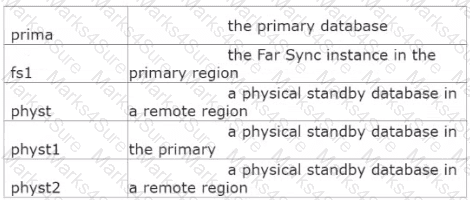Which FOUR database parameters might be affected by or influence the creation of standby databases?
You have a Data Guard Broker configuration called 'Somewhere' as shown:
DGMGRL> SHOW CONFIGURATION;
Configuration - Somewhere
Protection Mode: MaxPerformance
Databases:
Nearby - Primary database
FS - Far Sync
Farout - Physical standby database
Fast-Start Failover: DISABLED
Configuration Status:
SUCCESS
You then run this command:
DGMGRL> SHOW DATABASE 'Nearby' 'InconsistentProperties';
Which two are true about the output of this DGMGRL command?
Which two are true concerning the configuring of Flashback database in a Data Guard environment?
Which four factors can influence the rate of SQL apply on a logical standby database?
Active Data Guard (ADG) databases are widely used to offload reporting or ad hoc query-only jobs from the primary database. Reporting workload profile is different from the primary database and often requires tuning.
Which tool is used to tune SQL workloads running on an ADG database?
Which two are prerequisites for configuring flashback database for Oracle 19c databases, in a Data Guard environment?
Which two are true about managing and monitoring Oracle container databases in a Data Guard environment using the broker?
Your Data Guard environment has a remote physical standby database with real-time query enabled, which is used for reporting, and a logical standby database used for DSS reporting.
Switchovers or failovers are possible due to testing or in case of a disaster.
Clients use local TNSNAMES.ORA files to define connection strings to the database instances.
Which three will prevent clients from connecting to the wrong database instances?
You detected an unrecoverable archive gap in your data guard environment. So, you need to roll standby.
forward in time without applying a large number of archive log files using this command:
RMAN> RECOVER STANDBY DATABASE FROM SERVICE-
When running this command, which of the following steps can be performed automatically?
1. Remember all data file names on the standby.
2. Restart standby in nomount.
3. Restore controlfile from primary.
4. Mount standby database.
5. Rename data files from stored standby names.
6. Restore new data files to new names.
7. Recover standby.
A customer has these requirements for their proposed Data Guard implementation:
1. Zero data loss must still be guaranteed through the loss of any one configuration component.
2. The primary database must be protected against a regional disaster.
3. Performance overheads on the primary should be minimized as much as possible given these requirements.
4. Downtime on the primary database for any reason must be kept to a minimum.
Components referred to in the broker commands are:

A)

B)

C)

D)

You must configure on Oracle Data .......
1. A primary database
2. Three Physical Standby Databases
Examine these requirements:
A designated physical standby database should become the primary database automatically whenever the primary database fails.
2. The chosen protection mode should provide the highest level of protection possible without violating the other requirement.
Which redo transport mode and protection mode would you configure to meet these requirements?
You have a Data Guard broker configuration consisting of:
A primary database
One local physical standby database
One far sync instance
A remote physical standby database
The broker configuration was created with the DGMGRL utility after creating all the databases and the far sync instance with command-line tools.
What is the correct way to add this configuration to Enterprise Manager Cloud Control assuming all the nodes have been discovered already as Enterprise Manager targets?
Which feature is available when monitoring a Data Guard configuration using Enterprise Manager Cloud Control, but is not available using DGMGRL or by using SQL?
Examine the Data Guard configuration:

What happens if you issue "switchover to sheep;" at the DGMGRL prompt?
Which two are prerequisites for configuring Transaction Guard in a Data Guard environment?
Which THREE steps are prerequisites for the creation of a physical standby database on a separate server using the RMAN active database duplication method?
Which three Data Guard monitoring activities may be performed using Enterprise Manager Cloud Control?
You must configure an Oracle Data……….
1. A primary database
2. A physical standby database
Examine these requirements: 1. Data loss is not permitted.
1. Data loss is not permitted.
2. It should be possible to convert the physical standby database to a snapshot standby database.
3. Under normal operations, transactions should commit when redo is written to disk on the primary database and as soon as it has been received by the standby database instance.
4. The availability of the primary database should not be compromised by the availability of the standby database.
5. It should be possible to convert the physical standby database to a logical standby database
6. It should be possible to deploy Real Application Clusters on the primary database.
7. It should be possible to deploy Real Application Clusters on the physical standby database.
You configure SYNC redo transport mode in combination with Maximum Protection mode.
Which two Data Guard features require the use of flashback database by the broker?
A customer asks for your recommendation regarding this requirement:
1. We plan to have a Data Guard Configuration with one primary database and one physical standby database.
2. We want zero data loss in case of a disaster involving the loss of one component.
3. We want to do Real Application Testing occasionally on the Standby Database.
Which solution, if any, satisfies these requirements?
You are planning to perform block comparison using the dbms comp package:

Which TWO statements are true?
Examine the Data Guard configuration after an accidental switchover to Sheep:
DGMGRL> show configuration;
Configuration - Animals
Protection Mode: MaxAvailability
Databases:
sheep - Primary database
dogs - Logical standby database
cats - Physical standby database (disabled)
ORA-16795: the standby database needs to be re-created
Fast-Start Failover: DISABLED
Configuration Status:
SUCCESS
Which three statements will be true after a switchover to Dogs?